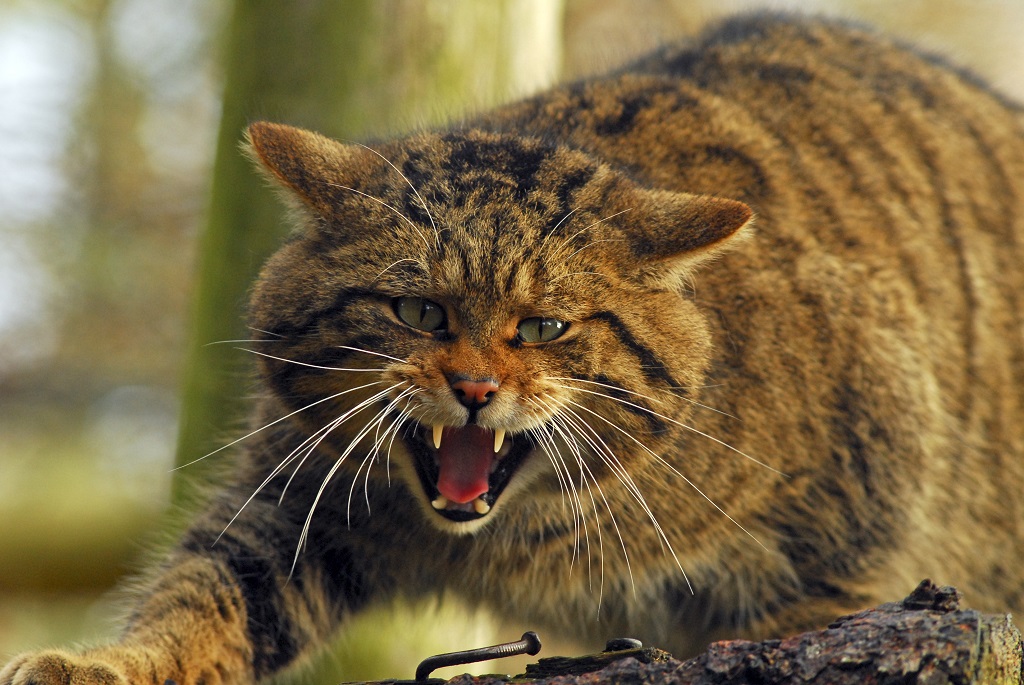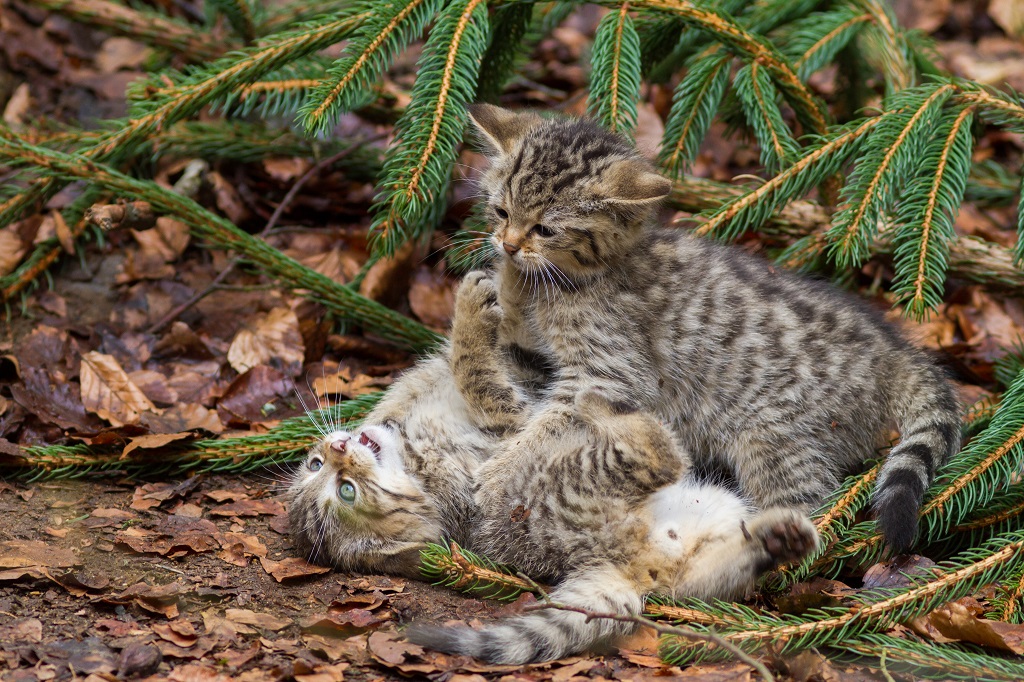
The fight is on to save the Scottish wildcat
After decades of decline, there is good news at last for the Scottish wildcat as a major conservation project aims to boost its numbers.
When I was a child in Ardnamurchan in the 1960s and early 1970s, wildcats were fairly common.
We’d see them hurriedly cross single-track roads at night, or vanish into the stunted oak and birch woods.
On several occasions when one got into the henhouse, I saw them up close. The spitting, explosive defence stance, back arched and eyes narrowed, was enough to make me flee.
Even in captivity wildcats never lose this distinctive threat posture – it’s what makes them so different.
Back then, wildcats were shot or trapped fairly regularly; sometimes someone might bring in a particularly beautiful specimen to show it off in the public bar of the Kilchoan Hotel; seeing such a magnificent animal with its luxuriant pelt, eyes glazed in a death stare, always upset me.
The Wildlife and Countryside Act of 1981 included wildcats on the protected species list, but they were still accidentally killed, mistaken for feral cats.
Over the past decade on visits to Ardnamurchan, I have had but the briefest of sightings – and even these might have been hybrids; it seems that even in the remotest part of this country, wildcats are all but gone.
Most of us have never seen a wildcat. A rough-coated tabby caught in a live trap might appear to the untrained eye to display all the credentials of our most endangered native mammal: the ears laid flat, the bushy tail with dark rings, and the glower and spitting hiss that warns us to go warily. Excitement mounts – could this be the real thing? Or is it merely some feral moggy with a smattering of wildcat genes? And how can you be sure?
After studying hundreds of wildcat skins, including some collected from museums and private sources dating back to the last century, Dr Andrew Kitchener probably knows more about the wildcat than anyone else.
He has been working on them at the National Museum of Scotland in Edinburgh for the past 28 years in his capacity as Principal Curator of Vertebrates.
Previously a researcher and field assistant for the BBC Natural History Unit, he is also an Honorary Lecturer at Glasgow University and an Honorary Research Fellow at Edinburgh University. His work and analysis of cat pelage colour and markings, in collaboration with Jennifer Ward, Nobuyuki Yamaguchi and Professor David Macdonald, has led to an understanding of seven key features that reveal whether a cat is truly a wildcat or not.
These include a unique dorsal stripe stopping short of the animal’s tail root, a blunt tail with a black tip, unbroken stripes on the flank and a lack of spots on the rump. Features such as white markings on paws and chin indicate that a cat is a hybrid.

The Scottish wildcat only has one litter of up to three kittens each year
The subject of wildcats has been hotly debated in recent years and there are several different organisations all promising to protect the creature. But loss of habitat, accidental persecution and continual hybridisation with domestic and feral cats means there are precious few wildcats left.
Given the remoteness of large areas of Scotland, no one can be sure of just how many pure wildcats remain. Dr Kerry Kilshaw of the Wildlife Conservation Research Unit at Oxford University, who has worked extensively on the subject, estimates the figure as between 100 and 300 – a frighteningly low number.
Now though, after endless depressing predictions, it seems there is finally a glimmer of hope. Scottish Wildcat Action is a major conservation project formed by a partnership between Scottish Natural Heritage, Cairngorms National Park Authority, National Museums Scotland, Royal Zoological Society of Scotland, the Scottish Gamekeepers Association, the Forestry Commission, Highland Council, the National Trust for Scotland and the Scottish Wildlife Trust among many others.
Partly financed by the Heritage Lottery Fund and the Scottish Government, this ambitious national plan includes a detailed land management strategy, as well as research to understand hybridisation and the all-important wildcat genes. There are trap, neuter, vaccinate and release schemes (TNVR) to minimise further hybridisation and disease spread from a burgeoning population of feral cats.
Areas where wildcats cling on can then be recognised as strongholds and prioritised for TNVR work; these currently include Morvern, Strathpeffer, Strathbogie, Strathavon, northern Strathspey and the Angus Glens.
Unlike domestic cats, the wildcat is not particularly fecund, producing just one litter of three kittens on average a year. Captive breeding is a vital part of the project. Working with the purest available wildcats, the aim is to eventually release young wildcats back into the most suitable habitat.
Excitingly in 2016, the Royal Zoological Society of Scotland has had considerable success with two litters of kittens born in Kingussie. It is also working with other zoos and wildlife parks across the country to breed even more animals for eventual release, in the hope that the wildcat’s full recovery may indeed become a possibility.
Much of this work is about genes, and recognition of the finest remaining specimens. While some wildcats may have small amounts of domestic cat genes, they can still display enough of their wild characteristics to be deemed suitable for inclusion in a breeding programme.

Scottish wildcat kittens at play
According to Dr Andrew Kitchener, this vastly complex subject involves many partners in postmortems, camera-trap photo scoring, coat-pattern analysis, screening for diseases, fieldwork and endless hours of genetic study to find valuable bloodlines. In 2015 more than 50 wild-living cat bodies were brought into the museum for analysis, many of them road casualties. It is essential to know the exact location of where each animal was found. Even old skins dating back years need to be accompanied by origin locations.
Twenty years ago, explains Andrew, the finest remaining animals lived in the wild whereas now, as numbers have crashed, it is the reverse and the purest specimens are to be found in zoos and private collections.
European wildcats are genetically closely linked to our own wildcats and these are relatively pure populations, particularly in Spain and Portugal.
By breeding Scottish and Spanish wildcats with each other, the Scottish gene pool would be strengthened. Andrew hopes that it will also be possible to reintroduce wildcats to suitable areas of England, though that dream could be some time off yet.
The Scottish wildcat matters because it is an integral part of a thriving and healthy ecosystem. Wildcat Action’s plans are timely, and now perhaps given time there will indeed be a future for the wildcat back where it belongs.
This feature was originally published in September 2016.
TAGS

